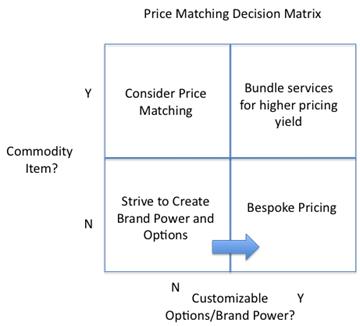Bloomberg Business Week recently featured an article on the business of price matching by major retailers . The gist of the discussion was how difficult price matching can be in practice, if not in concept. Let’s explore in depth the upside and downside of price matching.
Price matching can be used as defensive approach to maintain share, or as a promotion tactic to reinforce a low price image. Fear of losing traffic to competitors often drives retailers to match a competitor’s low prices – think of how closely matched gasoline prices are at stations on the same street corner! Other businesses can face the same competitive pricing threats as commodity outlets like gasoline stations but should be wary of the dangers of price matching.
Consider the example of a consumer electronics retailer. With so many SKUs, both consumers and store managers can become easily confused about what constitutes the same item. Quite often, customers demand a lower price on items that are comparable, but not exact matches. This leaves the store manager with a conundrum: lower the price on an item that may have a justifiably higher price, or risk offending the customer.
Retailers who don’t have a clear-cut policy on price matching can waste a lot of time, energy and customer loyalty by dithering. Do cashiers make the decision? Store managers? How are cashiers trained? What incentives do they have to make the right decision? You can see how chaotic and costly price matching can become.
Price matching also impacts brands by positioning the company as a follower, rather than a leader. Few business strategies yield higher returns by simply mimicking the competition. If price matching were the key to market share, then Amazon.com would not be the leading online retailer. Amazon’s prices are low, but not always the lowest. Amazon makes this quite explicit on their website:
“With the exception of televisions, Amazon.com doesn’t price-match with other retailers (including those who sell their items on our website).”
Amazon’s value proposition transcends low price; it is a blend of low price and an array of services that provide consumers with post purchase confidence and satisfaction. Amazon offers easy return policies, deep user generated content, delivery choices and other services that differentiate the overall shopping experience which, taken together create buyer loyalty and build market share.
Like Amazon, we at Abbey Road Associates, eschew the simple-minded price matching approach for retailers and beyond. The old adage in managing commodities is to customize the product with services and other attributes to raise total value. We use the decision matrix below as a starting point for discussion:
The key point is to avoid having to resort to price matching which erodes brand image, confuses employees and customers, and leaves a company with few options other than cutting costs and possibly quality to sustain profitability.
Developing a coherent price strategy is a difficult exercise, but well worth the effort that can build differentiating expertise and brand power. Rarely should you find your company facing a forced choice of either price matching or losing business. If this is a frequent occurrence, it’s time to review your pricing and positioning strategy.
Abbey Road Associates can help you think through pricing, packaging and branding options to yield higher returns and a more sustainable competitive position.


